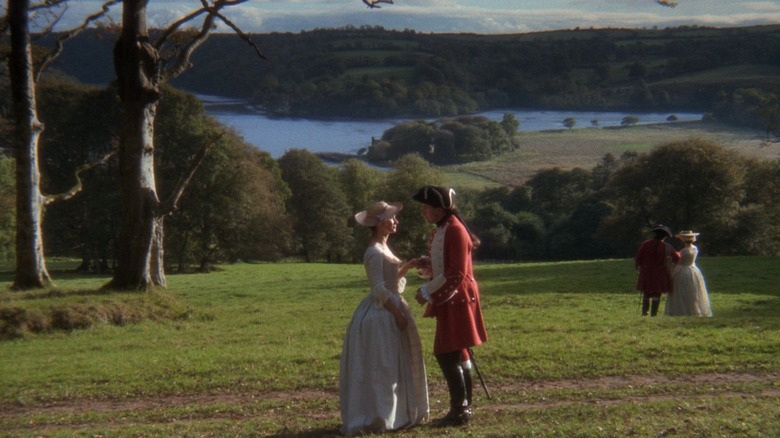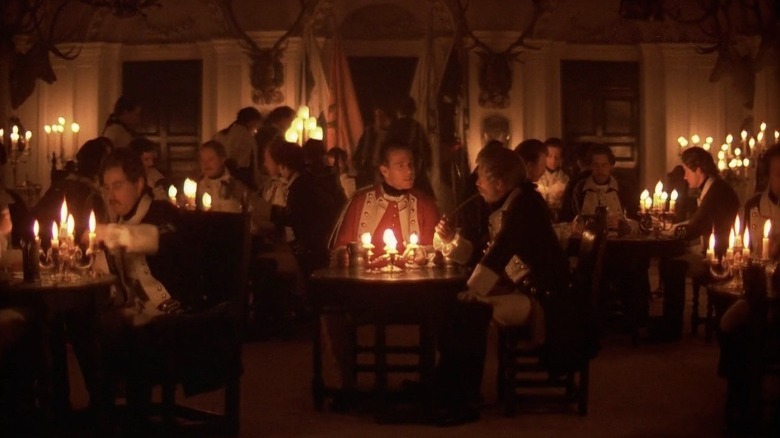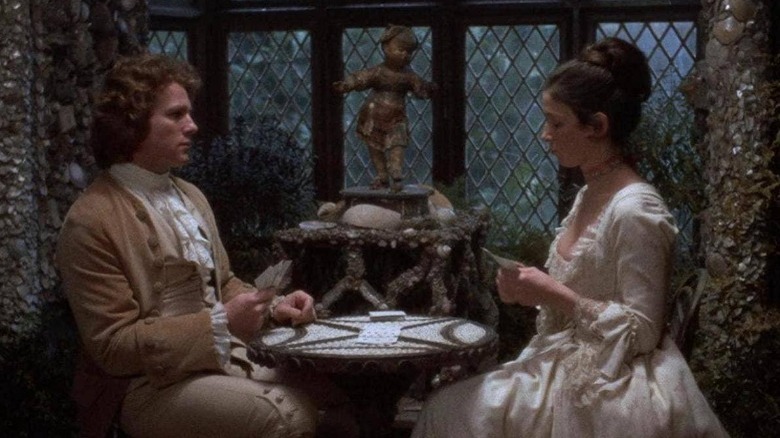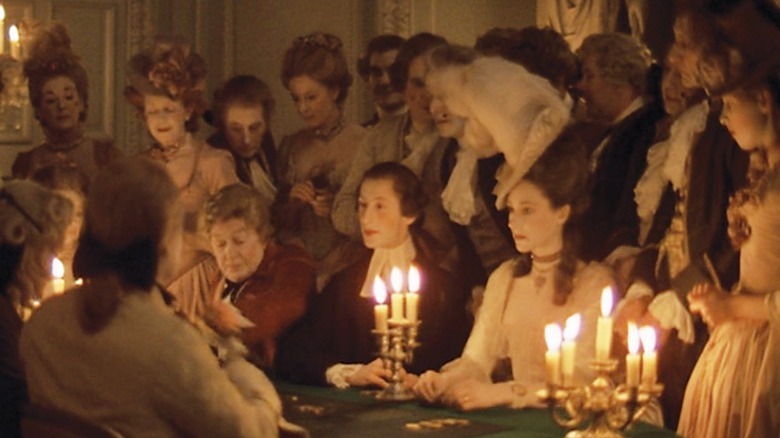Making Stanley Kubrick's Barry Lyndon Took A Huge Toll On The Cast And Crew
Stanley Kubrick's films encompass whole worlds, translating emotions and rituals into a unique and innovative visual language. Whether it's the Overlook Hotel of "The Shining" or the sterile space stations and star gates of "2001: A Space Odyssey," there's a disciplined quality to the movies' design and cinematography. There's also a sense of perfection, that every piece, from the costuming and the music, fits exactly where it must. Naturally, that obsessive tendency could be difficult for his collaborators. Kubrick demanded a great deal of them and himself.
Kubrick followed the science-fiction fantasias of 1968's "2001" and the dystopian grimness of 1971's "A Clockwork Orange" with 1975's "Barry Lyndon." It's a far cry from those earlier films, emphasizing the restrained emotion and ritualized violence of 18th century Europe. In painterly, colorful compositions, it traces the rise and fall of Irishman Redmond Barry (Ryan O'Neal), whose marriage to Lady Lyndon (Marisa Berenson) grants him a lordly title and a new surname. Out of the marriage, he also gets a creepily mother-fixated stepson, Lord Bullingdon (Leon Vitali), who becomes a mortal enemy.
The film's narrative complexities presented one challenge: to produce a period film that could document the pettiness of the European aristocracy in the late 1700's. That would require crafting something to the liking of Kubrick, an exacting and meticulous master filmmaker.
Lighting with candles
The most visually striking feature of "Barry Lyndon," beyond its remarkable compositions ripped from painter William Hogarth, is its candlelit photography. Kubrick wanted a pre-electric look to the interiors of the film. No lamps, no lighting beyond what was possible in the late 18th century. Because no sets were built for the movie, and the production team simply used old houses in Ireland and England, they experienced many difficulties getting proper, naturalistic lighting under Kubrick's dictates of minimal-to-zero electricity.
To film with only period-accurate candlelight required a unique set of lenses, faster and more open than any created before.
When cinematographer John Alcott and Kubrick first worked together on 1968's "2001: A Space Odyssey," Kubrick was already planning the creation of a never-made Napoleon film. While Kubrick labored over research on 18th-19th century Europe, he also struggled with fixing the candlelight problem, one of the many things that led to the delay and eventual demise of the Napoleon film.
In an issue of American Cinematographer, Alcott noted that Kubrick "discovered three 50mm t/0.7 Zeiss still-camera lenses which were left over from a batch made for use by NASA in their Apollo moon-landing program." Ed DiGiulio, a collaborator of Kubrick's who also developed the Steadicam, spent a long time customizing the lenses for filming purposes.
These extreme low-light lenses had an interesting effect on the actors as well. Critic Tim Robey claims the background players in those interior scenes had to move excruciatingly slowly so as to avoid underexposure. Ryan O'Neal claimed that one of the reasons production took so long on the movie "was that if we didn't get the take we had to blow all the candles out and start with new ones."
Kubrick and O'Neal
Stanley Kubrick could be rough with actors. The same attitude that had Matthew Modine once pull a knife on him also led to his cruel treatment of Shelley Duvall on the set of "The Shining." In his use of Ryan O'Neal as Redmond Barry, Kubrick challenged the actor's natural instincts and good looks, put to excellent use on movies like 1972's "What's Up, Doc?," to craft something unique.
Ryan O'Neal's performance as Barry Lyndon makes for one of the more difficult leading roles in Kubrick's filmography. He's meant to be a braggart, gambler, coward, and womanizer, but Kubrick's direction refuses to let the actor indulge in any natural charisma. Instead, O'Neal's take on Lyndon is somewhat ambiguous, incapable of lending a romantic quality to the character's wandering or visceral excitement to the film's war scenes. It's a brilliant and subversive choice, enough so that /Film put Barry on our top 10 Stanley Kubrick Characters List.
By drastically limiting the overt emotion of O'Neal's performance, Kubrick adds to the detached quality of his vision for "Barry Lyndon." The movie's a historical piece through and through, with an omniscient, passionless narrator detailing the immense emotional pain of its characters. According to the Guardian, O'Neal was only capable of getting through the movie's long-running shoot because of "a strong suspicion that I was involved in something great."
The supporting players
Even if he'd thought he was in something great, O'Neal was frustrated by the experience, as well as the length of the shoot, which lasted nearly a year according to Maria Pramagiorre's "Making Time in Stanley Kubrick's Barry Lyndon." As O'Neal wrote in his shooting diary, Kubrick "works you hard. He moves you, pushes you, helps you, gets cross with you but, above all, he teaches you the value of a good director."
He wasn't alone in either of his assessments. If Kubrick was something of a driver, it was always in service of making "Barry Lyndon" a greater film. When he struggled with the composition of a shot or the direction of a scene, he would pose O'Neal and Lady Lyndon actress Marisa Berenson in the postures of 18th century portraiture. In the commercial American way of making movies, that could seem like a waste of time — in "Barry Lyndon," it deepens the actors' connections with the world they depict.
The supporting cast, generally below O'Neal's movie star paygrade, treated Kubrick with awe and respect. Describing his unusual non-audition for the role of Reverend Runt, Murray Melvin said the build-up for Kubrick's arrival "was fit for a Roman emperor." The devotion of actor Leon Vitali, who played adult Lord Bullingdon, was such that he gave up a promising acting career to serve as Kubrick's personal assistant following completion of the movie, until the director's death in 1999.
The difficulties accompanying the creation of "Barry Lyndon" may have been immense, but as an ensemble acting piece, it exhibits the finest direction of actors in Kubrick's career. O'Neal claimed the whole cast was "crazy" about the director.



